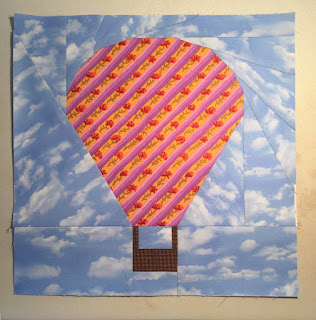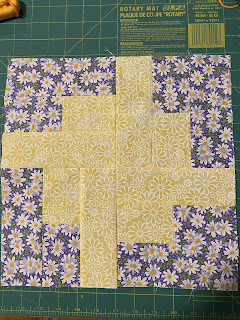Hello Hive Mates!
Hello Hive Mates!
October is my favorite month – I love the weather, the
leaves, the first storms rolling in. So, I’ve selected something else I love
for you all to make: hot air balloons. This pattern is being done as paper piecing.
I know in the poll some of you indicated an unfavorable history with the
technique. I’m asking that you give this pattern a try, but if things go
terribly wrong, make a post ranting about it with a picture of your attempt,
and don’t worry to much about forcing yourself to actually finish the block.
 |
| Diagram of piecing sections |
 |
| Coloring page for the block |
Back to the pattern. The balloon itself can be anything you like – maybe there’s a great print you’d like to showcase or a practice block that doesn’t belong to a quilt or a piece of crumb quilting (an option as I tried my hand at here). The easiest and fastest will of course just be a single fabric. I have no requests on colors (maybe no baby prints) for the balloon so go wild! I am requesting that the background/sky read as blue and the basket/ropes as brown though I don’t care if these are patterned or even scrappy. Here are a few examples of the block sewn with a crumb center, a single fabric center, and a scrappy background.
This block is sewn in two sections, the balloon and the
basket which are then joined. The final block should measure 12.5*12.5 inches.
The balloon section pre-joining should measure 12.5*9.75, the basket
pre-joining should measure 12.5*3.25.
Before I jump into instructions there are two documents I want to provide you. The first is a PDF with all of these instructions, the piecing patterns, and the cutting patterns (for those who don't love working off a computer screen). It can be found here. The second is the paper piecing patterns with the cutting patterns for those who want to use paper piecing while making this, found here. Note that these will be linked several times throughout the post so no need to open them all now, I just wanted to put them somewhere convenient for you all. Whichever you print, ensure that it is set to print at 100%. If you are an experienced paper piecer and don't feel like reading instructions, please note that the cutting templates are designed to be placed on the backside of the fabrics.
Please ask lots of questions if you have any – this pattern
is one I designed and it’s my first time writing a pattern for other people.
Diana and a few others have kindly tested it for me, but a pattern is always a
living document, so let me know if something needs clarification! For those new
to paper piecing, or who want a refresher, here are a few great tutorials on
the technique – how to line things up and be sure that the pieces fully cover
the intended area after sewing a seam.
Paper Piecing Tutorial 1
Paper Piecing Tutorial 2
Paper Piecing Tutorial 3
Instructions:
Cutting:
Balloon: Cut one piece using the template from Balloon
cutting sheet.
Brown:
Cut 3 pieces using the templates from Browns cutting sheet
Blue: Cut
pieces B-O using blue cutting sheets 1-4. Place the cutting sheet on the wrong side of the fabric.
Note: Cutting sheets have a ½ margin added to
the pieces, EXCEPT the balloon, which only as ¼” seam allowance marked (because
otherwise it wouldn’t fit on a page)
Figure 1; Cutting sheets for blues
Figure 2; Blues and balloon cut out
Piecing:
1.
Cut out balloon paper piecing templates 1 and 2 and
tape together at dash marks.
2. Start by placing piece A (the balloon) on the paper and
joining piece B (blue). Press the blue piece away from the balloon. (In this
section, piece A is the balloon and all others are sky).
a.
Tip for paper piecing: shorten your stitch length to
make the paper easier to remove.
3.
Continue adding pieces in alphabetical order pressing
between each piece.
a.
Triangles are added to the main piece by aligning and
sewing along their longest edge.
Figure 3; Example of the addition of the pieces around the balloon
b.
To make piecing easier, fold paper back along the next
sewing line and trim the last added piece to ¼” before lining up the next piece
(See trimming example below)
Figure 4; Trimming the edge to be sewn before adding the next piece. This is not completely necessary but will make it easier to line up the next piece.
c.
Sew directly on the line (as shown below) when adding
pieces.
Figure
5; Sew directly on the line when adding the next piece.
4. Cut out the basket piecing templates from the basket
piecing sheet and tape at the dash marks. (For the basket segment, pieces 2B,
2C, and 2D are brown for the basket. All other pieces are sky)
5.
Start by pinning section 2A to 2B and sewing across the
line. Press open.
6.
Continue adding segments alphabetically, pressing and
trimming as above for each segment
Figure 6; Image showing sections 2A-2E sewn together with 2F
and 2G ready to add.
Figure 7; Entire basket section sewn together
7. Join to the balloon, matching the bottom of the balloon to the rope of the basket piece. Press
8.
Trim to 12.5*12.5”
You’ve made a hot air balloon! For anyone who struggled, go treat yourself to a piece of chocolate (and anyone who didn’t struggle for
that matter). Feel free to leave the paper on or tear it off if you have issues
getting it into the envelope. I look forward to seeing what beautiful balloons
float my way!

























































